
The Truth In Chiropractic and Health Care Marketing




AI is all the rage. AI art, AI music, AI writing, and on and on.
These services are impressive. Manufactured-for-you newsletters, articles, art, and music. All done at relatively high quality.
AI could replace writers, artists, and musicians as it has with taxicab drivers with Lyft and Uber. Maybe it will soon replace truck drivers, computer coders, customer support specialists, media jobs, legal assistants, accountants, etc.
So, I wondered, how about chiropractors?
I asked a few AI-powered services about the future of chiropractic and how AI might affect chiropractors. Here is an example of one of the answers:
“Could AI replace chiropractors?
“According to the current research, AI is unlikely to replace chiropractors [3]. Chiropractors perform several tasks that require human capabilities, such as manipulating the spine and musculoskeletal system to treat patients, diagnosing health problems, and advising patients on recommended courses of treatment. However, AI can assist chiropractors in various ways [1]. AI can help with data management and analysis, providing insights for personalized care and health research. Moreover, AI can save time and money, allowing for more high-level tasks and automated back office work in a chiropractic clinic. It can help clinics put computer intelligence to work and improve patient journeys [2].
References: [1] Chiropractic application of artificial intelligence in medical … [2] Chiropractors Embrace Artificial Intelligence and Create … [3] Will “Chiropractor” be Automated or Replaced By Robots?
= = =
So, for now, I think you’re safe. But automation is increasing – exponentially.
In my book, the Goal Driven Business, I address this issue and refer to other scientists and authors who have studied the subject.
“Your Replacement is Being Shipped Now
“According to Richard and Daniel Susskind, the traditional professions will cease to exist in the state that we currently know them. In their very capable book, The Future of Professions, the authors state: “Whatever terminology is preferred, we foresee that, in the end, the traditional professions will be dismantled, leaving most (but not all) professionals to be replaced by less expert people and high-performing systems.” (Page 185)
= = =
Obviously, no machine is going to adjust patients any time soon.
But we have to be careful that we don’t substitute AI and automation for our personal care for our patients.
I recently talked to a chiropractic assistant about sending out birthday cards to patients. You, know, an actual card (postcard), hard copy, mailed. She couldn’t see the point. “Why not just send a text? It’s part of our automated program.” I pointed out that the text could be coming from an apartment in Nigeria, and your patient would never know the difference.
Nothing against texting, but our world is superficial and impersonal enough.
Here is my recommendation: AI, automation, and electric screwdrivers are all tools. Used correctly, they can help you provide better service. Used incorrectly, you can be persuaded to have automation take the place of you.
A pathetic example is the bulk chiropractic electronic newsletters you can buy as an automated service. I am all for newsletters, but these types of newsletters do not improve the communication between the doctor, the office, and the patients. They are just bland content.
This is why we help our clients send out their own newsletters to their patients.
AI and automation will never replace you if you utilize them as tools to improve your services, outcomes, and communication with your patients and patients to be.
Delegate and Automate
But Don’t Abdicate
Happy Spring(Autumn Down Under!)
Ed (Written by Ed Petty!)

Start Each Day with Service First
Do you want a fast, simple and very effective procedure that
Beginning Each Day With Service Goals for Each Patient
Too often, we start our days by first looking at the appointment book when the patients are already waiting for us. The staff may not know what special needs each patient has, or they may have been told something by a patient that should be passed on to the treating chiropractor.
A brief review of each patient can help coordinate patient services with the entire team.
Case Management Meeting Procedure
Meet with your team about 20 minutes before you see the first patient each morning. Review the patients individually that are coming in that day. You may not need to go over every patient, especially if you have a full book.
Discuss each patient and what the goal of their next visit should be. Do they need therapy or rehab procedures? What kind? Is it time for their progress exam? Did they voice a concern to a team member that you need to know about? Do they need another financial consultation or educational materials? Should they bring in their spouse?
You can also discuss new patients – what do we know about them? Are they a friend of Rihanna or Marge Simpson? Do they live in the high-rent part of town or in a trailer down by the river? Are we all looking forward to meeting them?
More Than Case Management – Keeping It Fun.
Aside from case management, the morning meeting helps get the day started. Everyone can see how each other is doing, say Hi, and be on deck all set for the day.
I have seen chiropractic offices do short exercises (practice what you preach!), such as a plank or wall sit exercise.
I have seen jokes told. For example, everyone is assigned a spot on the Bad Dad Joke Rotation. One joke per day. The most joke for the week (the best one) gets free lemon and beet juice!
You can set reasonable goals for the day – new patients, visits, case completions, etc.
You can add a motivational quotation or review the mission or a core value.
I have personally seen this applied in many offices. Often, the primary chiropractor would get to the morning meeting first, and anyone who came in late was duly noted!! One office did this procedure in the morning and then again before the afternoon crowd came in after lunch.
Assign this as a procedure to your manager, case manager, or front desk coordinator. But make sure you support it 100%.
I have seen case management meetings work for a few months and then, like many procedures, fall by the wayside.
It only works if it is done.
In the end, everything we do is to help each patient reach their goal of better health, and this is the ultimate goal of case management meetings.
Over to you!
Carpe Posturum! (Sieze the Future)
Ed
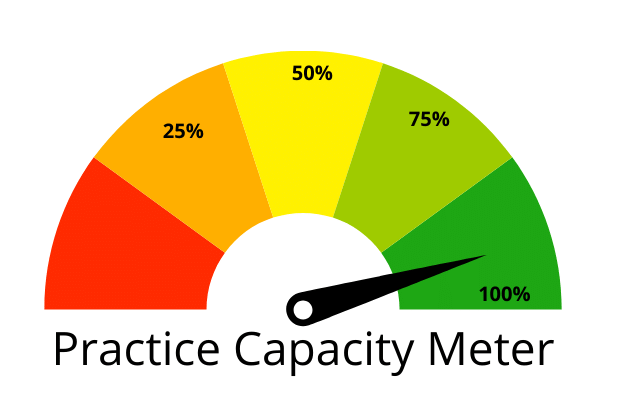
Fixing the weakest links.

Your practice should flow smooth, fast, and uninterrupted, like a clear mountain stream.
Most offices, unfortunately, have hidden dams that slow or even block the flows within their office. This limits growth and increases stress.
For example, I have often seen the front desk so clogged with paperwork that new and active patients were inadvertently discouraged from coming in.
Every department and function of your practice is vulnerable to innocuously seeming events that add friction that choke production. Interruptions in the billing department, poor note-keeping systems for doctors, too many therapies to choose from, insufficient space, staff unclear of their goals, staff driven into apathy by being micromanaged… there are many potential opportunities for roadblocks.
Generating more new patients to increase your patient volume is usually a good idea. But often, the increase in volume is short lived because the office had too many hidden log jams and wasn’t set up for the higher patient volume. Even the doctors, while saying they want more new patients, can become fatigued by the end of the day and privately look forward to lighter days.
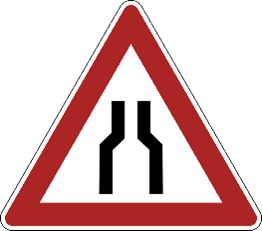
There are several remedies for these clogged flows.
First, clear up the goals and outcomes of each department. For example, the goal of the front desk is not “completed paperwork.” (A “Fully Scheduled Day” would be better!)
Second, you can review and refine the flow of patients into, through, and out of your practice. Draw a patient flow chart. Start with your new patients. List the sequence of actions your new patient goes through on their first day at your office. Later, you can do this for their second and third day. You can later work out a flow chart for reactivated patients, re-injured patients, and different types of cases.
Then, you and your team can rehearse the entire sequence to see what is missing or what needs to be eliminated.
I cover this in The Goal Driven Business:
Broken flow patterns that remain invisible “clog up” the system and slow down everyone’s best efforts to produce valuable outcomes and excellent service. These are bottlenecks. Discovering and eradicating them is a significant function of the Goal Achievement Process.
In his 1984 book, The Goal, Eliyahu Goldratt introduced what has come to be known as the “Theory of Constraints.” By making a chart outlining the flow of your customers, for example, you’ll better identify “leaks” or constraints which lessen your ability to achieve high quality and quantity customer outcomes.
As Goldratt states, “Since the strength of the chain is determined by the weakest link, then the first step to improve an organization must be to identify the weakest link.”
Every three months or so, do a “walk-through” with your entire team, where someone takes on the role of customer. This rehearsal will bring to light many duplicated or omitted functions. You’d be surprised to discover that many of the tasks you assume are done for your customer are actually skipped or poorly linked in. Sometimes you find tasks from decades ago, that no longer apply, are still being done.
Be an engineer to your goals and discover the constraints holding your office back, and remove them.
Be…… A Goalineer!
Ed
PS For those of you who have purchased my book, The Goal Driven Business, you are welcome to schedule a no-charge consultation to see how you can remove your bottlenecks and achieve your goals. SCHEDULE NOW
If you haven’t purchased the book yet, please do so here. BUY THE BOOK

In a Goal Driven Practice, Goal Driven Job Descriptions are short, fast, and to the point.
And they are used!
They help improve the quality and quantity of services and are motivational.
So, how is this different from other job descriptions?
Most job descriptions are usually a hodge-podge and catchall of unrelated tasks. For example, the front desk job description may include getting supplies, taking x rays, calling attorneys, and scheduling patients. Billing may include marketing and equipment repair.
Staff will do the tasks assigned but end up zigzagging from one function to another, losing focus on what they are doing, and often disengaged in their activities.
In typical job descriptions, the goals are not clearly defined, measured, nor are the expectations stated. Further, employees don’t always see or get recognized for the results of the work detailed on their job descriptions.
Yet another failing of most job descriptions is obvious – they just aren’t used.
Let’s look at how to power up job descriptions so that they are Goal Driven.
Many job descriptions contain the duties of several different roles. A role is an assumed identity. For example, in a restaurant, there are the roles of a server, cashier, dishwasher, and chef, or cook. In a small restaurant, one person may take on a number of these roles, and all these roles would be their job description. Hence the idiom: “chief cook and bottle washer.”
But to be effective, each role needs to be separated, well defined, and organized with the other roles.
In a Goal Driven Practice, job descriptions are broken down into different roles and described in job checklists.
The job checklist begins by clarifying the goals. This includes the mission, the outcomes, what is used to measure performance, and the level of performance expected of that role.
For example, for the role of Patient Accounts, the mission might be something like: “To help the patient pay for all of the services they received in such a way that they will continue to receive services.” The outcome might be a zero balance or “no accounts receivable more than 30 days.” The statistics used to measure this role could be the “percent of collections to adjusted services.” And finally, the expectation might be something like: “All patients very happy with the encounters with Patient Accounts and continuing with their services, with a collections percent of at least 95% of adjusted services average.”
We now list the most important procedures to achieve this goal. The CEO of the office defines WHAT the goals should be – that is leadership. But the manager and those working in patient accounts would work out HOW the goals would be achieved.
Encouraging the team member to define the best procedures to achieve their goals empowers them and gives them autonomy and responsibility for their role. According to Self-Determination Theory, real motivation is intrinsic. It comes from one’s desires and needs rather than external rewards or threats. Edward Deci, in his book Why We Do What We Do, says people “strive for personal causation.” (This is more fully covered in my book, The Goal Driven Business)
If the cook understands that their goal is to make tasty meals that the customers enjoy and for which they will pay, they can be more responsible for how best to achieve that goal.
A team member may have five or more roles, each with a job checklist, as part of their job description. As the doctor and owner, you may have 25! (And if so, that could be a big capacity barrier right there!)
Once the goals are clearly defined … and kept in mind, the rest of the checklist can be easily worked out.
Once per month or more, you or the manager can meet with each team member and do what we call a Coaching Review. This is a fast review of employee performance: at what they are excelling and at what they need to improve. In addition, the job checklist can act as an assessment.
But it is all geared around the goals of their roles. You also ask them what could be added or changed to improve both the quantity and the quality of their outcomes. They can make the changes to the job checklist and make sure you have a copy.
None of this takes a long time to do each month.
Management of your office is not just about getting procedures done. It is about constant improvement in the quantity and quality of their goals.
You may have told your patients something like: “If you do not make time for your wellness, you will be forced to make time for your illness.”
The same applies to managing your business. “If you do not take time to improve your procedures and your people to achieve the goals in their roles, you will be forced to make time to rebuild your practice.”
Steven Covey, in his book The 7 Habits of Highly Effective People put it simply and best:
Begin with the end in mind.
Ed
A year ago, who knew what the next 12 months would be like?
Yet, here we are today.
As the New Year is just before us, again, one can only wonder at what the future holds. Is this the “New Normal?” How far will it shift in the next twelve months? For you, your patients, and your business?
Wha tever new realities lie ahead, we are ready to help you and your business. We will be launching a new approach to practice and business building with the theme of Faster to Your Future in January. It is based upon the book the Goal Driven Business.
tever new realities lie ahead, we are ready to help you and your business. We will be launching a new approach to practice and business building with the theme of Faster to Your Future in January. It is based upon the book the Goal Driven Business.
But just before we start the New Year, I wanted to pass along a message of encouragement.
It often amazes me that with all the wars, both “hot” and cold, the greed, the fear, and tyranny, with all of mankind’s utter insanity over the centuries, we are doing as well as we are. Somehow, as Abraham Lincoln predicted in his first inaugural address in 1861, “…the better angels of our nature…” came through and prevailed. Whatever challenges we may have, his were enormous. He was facing a nation divided, secession of the southern states, the policy of human slavery, civil war, and a world of other conflicts.
But in the end, there is something about the Innate Goodness of Life that seems to propel mankind forward towards a better future, however slightly. I think that the more we trust in the Better Angels of our Nature, and in the Goodness of Life itself, the more sure our road will be toward a better year for us all and a happier future.
“I have one life and one chance to make it count for something . . . I’m free to choose what that something is, and the something I’ve chosen is my faith. Now, my faith goes beyond theology and religion and requires considerable work and effort.
My faith demands — this is not optional — my faith demands that I do whatever I can, wherever I am, whenever I can, for as long as I can with whatever I have to try to make a difference.”
― Jimmy Carter
So with this, we look forward to working with you to help make 2022 both prosperous and rewarding.
With admiration from all of us at Petty Michel and Associates,
Ed
A few years ago, a staff member at an I office visited confided in me and told me the following story:
“Our office was really slowing down last year. So, the doctor decided to take everyone out of town to a weekend practice management seminar. The speakers discussed really cool methods for doing our work. It was fun and we learned a lot. Plus, we also went over some great marketing ideas. We were all pretty excited when we returned to work after the weekend.
“On Monday, we agreed to get together at lunch to discuss how to implement what we learned. Some staff members were still dealing with patients, so our lunch meeting started 30 minutes late. Once we finally got together in the break room and started eating, we began a good meeting. We were interrupted with a few phone calls, and some patients started arriving early for their afternoon appointments. We had to cut the meeting short and didn’t get to discuss much of topics of the seminar, but we agreed to continue the meeting the following week.
“As it turned out, something always came up each week and… we never did meet again about the seminar.
“But we were still pretty pumped from the seminar and we had one of our best months ever. It was my job to clean the break room and, after a few months, I noticed that the binders of information we received at the seminar were still on the break room table, never opened. I stored them away for future reference.
“Now it is almost a year later, and everything is pretty much back to the way it was before we went to the seminar. The numbers are back down, some of us are a little burned out, and I don’t think we ever did implement anything from that seminar.”
—
Sound familiar?
I bet it does. I have seen it play out almost the same way countless times.
We are in the improvement business. We help people improve their health. We should be able to do the same for our business and for each other. In fact, if you are not constantly improving, your patients will seek practices that are.
In this new decade, apart from the many new events and changing tides of culture, technology, and mega-corporate influence, your future success is up to you. And it will be primarily based on the quality of your service and your outcomes – the experience your customers receive.
A report from a survey by Microsoft underlines this:
“As customer expectations continue to climb, it becomes more challenging for brands to set themselves apart from the competition. Markets are increasingly crowded, and both price and product are being steadily overtaken by customer experience as the number one brand differentiator” (Microsoft 2018, State of Global Customer Service Report).
More than any other short-term marketing tactics you may be using, only the best offices will thrive in the long run. And those will be the offices that are working on consistent improvement. Mediocrity could get you by in the past. But now, the future belongs only to the best.
But I have noticed that most offices just do not spend enough time consistently on improving their performance. After studying this for some time, I have observed a number of obvious and even hidden barriers that prevent us from working on improvement. I will explain what these are in a later article, but the following steps can help you ensure that you work ON your business to improve it, not just work IN it.
Your car mechanic can’t work on your car when you are driving it down the freeway. You can’t see patients while they are driving their forklift at work or cooking dinner for their kids at home. You need a separate time and place dedicated to work on improvement.
Your goal is to create an expert office that generates expert results and gives your patients the best experience they can receive from any other comparable health care business.
Imagine your business being so good that patients not only drive in from across town, or even across the state, but fly in from all across the country to receive your services. Imagine that there is such a demand for your care that you even build a motel next to your facility to accommodate the out-of-towners.
Well, there was a Doctor of Chiropractic who was just that good. His name was Clarence Gonstead. His advice?
“Practice. Practice. Practice. Never stop.”
Ed

“To remain indifferent to the challenges we face is indefensible. If the goal is noble, whether or not it is realized within our lifetime is largely irrelevant. What we must do therefore is to strive and persevere and never give up.”
Tenzin Gyatso, 14th Dalai Lama
(Beyond Religion: Ethics for a Whole World)
For a printable copy of this tent poster email services@pmaworks.com
Four steps to continuously develop and improve your practice
The Practice Development Process is a simple, yet powerful practice building system that can help take you and your business to its full potential of a systematized, team driven and profitable business.
It transforms your practice. Month by month, it helps move your practice to a more profitable service oriented business that runs at near full capacity – with less ups and downs that demand your time and extra work.
It is based upon the idea of constant improvement.
The principle of constant improvement in management science has been a major factor in the success of large manufacturing corporations around the world. The success of the Japanese automobile manufacturing rests heavily on a process of constant improvement called Kaizen (kai = change, zen = good). Motorola developed its own program called “Six Sigma”, a process of continuous improvement.
We have adapted these processes to be applied in practice management and call it the 3Goals Practice Development Process (PDP).
The Practice Development Process has four steps:
Integrate This Process As Part Of Your Team Meetings. The first two steps, Assess and Plan, are usually done before or during the first staff meeting of the month. Supervision goes on during the month to ensure that the plan gets completed. At the end of the month, successful procedures are documented in a practice playbook for future training and assessments.
Your Consultant and Coach. This process is best done with your practice and business coach. Each month, the two of you should work through step 1 and 2. During the month, your coach may also be able to help with the implementation of the plan.
THE 4 STEPS OF THE PRACTICE DEVELOPMENT PROCESS:
1. Assess and Review. At the end of the month, look over the statistics and note what areas improved and what areas didn’t. Then check what was actually done, or not done in each area. Use your departmental checklists from your Practice Playbook if you have started this.
Many business owners still manage without looking at objective indicators. They manage by emotions, mistakes, fear, “bright ideas”and other flighty factors that ultimately hold a clinic back, or often just burn it out.
Effective clinic managers, like an athletic team coaches, base their actions first on actual outcomes and performance monitors. These are your daily, weekly, and monthly practice statistics. PM&A has developed a specialized form of review which is called Practice Analytics System which we display on our client’s personal Practice Dashboard’s.
This assessment also includes reviewing checklists of the key procedures and whether or not key duties were done.
2 Plan. Work out the key areas you want to work on in the next month. Pick just one or two areas that will make the biggest difference and make a list of a few action steps that will help improve the area in your office you have targeted. Get the actions assigned with a date on when they should be done.
3 Supervise. Regularly monitor the implementation of the action steps with yourself, your team, and your consultant. Provide help where needed to get them done.
4 Systematize. You do not want to keep inventing the wheel, so at the end of each month, document any procedure that worked well.
List all successful activities for each department and “lock them in” as standard operating procedures. Keep what works, throw out what doesn’t. Start with just a checklist of key procedures. Later, you can write or videotape a description of each procedure. It is from this that you will do your training and “coaching reviews.” Use your playbook often: refer to it and practice.
Gradually, you should have your own system of practice management and patient management and have it outlined simply in your Practice Playbook. For example, the “Smith Chiropractic System of Patient Management.”
IMPLEMENTATION SCHEDULE
Week 1. First Week of the Month: Do Steps 1 & 2 – Assess and Plan
Week 2. Supervise. Coordinate upcoming activities. Study and Train. (Optional: Separate Marketing Meeting)
Week 3. Supervise. Coordinate upcoming activities. Study and Train.
Week 4. Supervise. Coordinate on upcoming activities. Celebrate and party for a great month! Add to Practice Playbook.
REPETITION
Do The Practice Development Process Every Month.
The success of this process derives much of its power from a simple principle from Aristotle.
“We are what we repeatedly do.
Excellence, then, is not an act, but a habit.”
This often referenced quote is from a series of lectures he was to have given at the Greek Lyceum on ethics (300 B.C.). We could say, then, that continuing to do the Practice Development Assessment, and all of your procedures and systems, is ethical and leads to excellence. The contrary would also be true.
GOALS AND CONSTANT IMPROVEMENT
It is important to keep in mind WHY we are doing the PDP each month.
It is assumed we all want to improve, that improvement is possible, and that we have higher purposes and goals. Our patients do. That is why they see us and we help them improve and get closer to their goals at each visit.
By consistently working the 3 Goals Practice Development Process each month you, the practice, and each team member will also get closer to the higher goals each of you share.
They both can be expensive, so what service gives the greatest “bang for the buck?”
I go to seminars. I like them. In fact, I hope to see some of you at the WAVE, sponsored by Life West in San Francisco this weekend (8/1/2014). (If you are going please contact me by calling the office number below and it will forward to my phone. It would be great to say “hi” in person!)
Seminars provide a good opportunity to get away. B.J. Palmer talks about this, of course, in his Rule Number #9. (1)
Also, by disengaging from your work, you can better re-engage in it when you get back. The science of this is discussed in a book called: The Power of Full Engagement.
Plus, networking. Nothing like meeting new people and hearing how and what they are doing and trading fish stories – even if they are often embellished. (“Don’t tell fish stories where the people know you; but particularly, don’t tell them where they know the fish.” Attributed to Mark Twain.)
And, they can be entertaining.
Plus, you can learn things. Learning new things that work and unlearning things that don’t work is probably the MOST important skill you can have. And it is getting more important every day. Our world is changing SO fast that in order to keep up, you have to really spend time and money learning.
“The illiterate of the 21st century will not be those who cannot read and write, but those who cannot learn, unlearn, and relearn.” ― Alvin Toffler
However, there are drawbacks.
First, there is the expense of the seminar. Actually, by comparison, most chiropractic seminars are dirt cheap compared to other seminars that run into the thousands. The expense is in the travel. The hidden expenses add up considerably, especially if you take your staff, which you should now and then.
Then, there is the actual content – the information being imparted. Much of it is motivational and that is nice. However, the seminar speaker does not know you. He hasn’t been to your office, your home, talked with your staff or know your family. He hasn’t read your town’s newspaper or seen your patients. He doesn’t know your situation. He teaches you a procedure that sounds good in theory and may have even worked in his office 15 years ago, for a while. He may be entertaining, or coercive. But, often only 10% of what is taught at a seminar is applicable to you and your office. And of that, very little gets implemented, and in two months, less than 5% of the seminar may be in operation at your office. The following is an example that shows how much useful information gets reduced down to actual implementation in most offices.
Actual Value of Seminar (approximate percentages)
This example is a little harsh, I‘ll admit, but I wanted to make a point. But you know what? Even this small percent may still be worth attending the seminar.
Our company grew because doctors did not or could not adequately apply what they heard at the seminars. Starting out many years ago, I remember seeing doctor’s shelves full of binders, VHS cassettes, and manuals that were barely touched since they were brought home from the seminar.
So, back in the late 1980’s, we came up with our niche and our identity, encapsulated in our tag line:
When Seminars Aren’t Enough sm
Good coaching, helps you and helps your team discover what systems work best for you, and then helps you make them better – over and over until your TEAM becomes expert.
A good coach, like a competent doctor, has the experience to quickly identify what needs to be worked on that can bring about the quickest improvements. This is what we do. We have become skilled at spotting the key leverage points (3) in an office and have developed new and effective methods to make the changes necessary for faster improvements.
But, we do this as your guide. We don’t impose a particular patient system into your office. You are unique and what works for a doctor in Nebraska may not work for the same one in San Diego. We help you discover what works best for you and help your team get better at supporting you.
A good coach trains, advises, nudges, listens, counsels, teaches, and when possible, even does some of the work. And is this effective? You sure as hell bet it is! We have been doing this for nearly 30 years and those doctors that have worked with us know this to be true.
But the real reason for coaching is economics: bottom line, baby! Return on Invest. ROI. Studies show a pay back of 5 to 7 times on your investment. We have certainly seen this occur. (3)
Like chiropractic, good care doesn’t cost, IT PAYS. Health IS wealth. The same applies to education – and in particular – coaching. It doesn’t cost – it pays.
Seminars? Yes. Coaching? Hell yes! But books and webinars and mentors as well. A weekend of reading a book is a great investment.
In the end, you have to constantly study and learn to stay in the game. Success is, now more than ever, dependent upon constant never ending improvement. You have to do this just to keep up, let alone to get ahead.
And if you don’t – well, your community and patients will be seeking a healthcare office that is.
References
(1) Rule #9: Every man owes it to himself, his people and his service to go away about every so often. The more detail he has, the oftener he should go. The more worries, the more he needs to go. The bigger his work, the longer his vacation should be. – B.J. Palmer https://pmaworks.com/observations/2008/08/18/getting-away-rule-9/
(2) Leverage Points http://www.donellameadows.org/wp-content/userfiles/Leverage_Points.pdf , also: Eli Goldratt, The Goal
(3) BUSINESS IMPACT STUDIES
Improved Relationships 77%
Improved Teamwork 67%
Improved Job Satisfaction 61%
Improved Productivity 53%
BUSINESS PRESS EXCERPTS
“Many of the world’s most admired corporations, from GE to Goldman Sachs, invest in coaching. Annual spending on coaching in the United States in estimated at roughly $1 billion.” Harvard Business Review
“Coaches are not for the meek. They’re for people who value unambiguous feedback. All coaches have one thing in common. It’s that they are ruthlessly results-oriented.” Fast Company Magazine
“Business coaching is attracting America’s top CEO’s because, put simply, business coaching works. In fact, when asked for a conservative estimate of monetary payoff from the coaching they got….managers described an average return of more than $100,000 or about six times what coaching had cost their companies.” Fortune Magazine
“[A Coach] is part advisor, part sounding board, part cheerleader, part manager and part strategist.” The Business Journal
“Between 25 percent and 40 percent of Fortune 500 companies use executive coaches.” The Hay Group International
“Once used to bolster troubled staffers, coaching now is part of the standard leadership development training for elite executives and talented up-and-comers at IBM, Motorola, J.P. Morgan, Chase, and Hewlett Packard. These companies are discreetly giving their best prospects what star athletes have long had: a trusted adviser to help reach their goals.” CNN.com
“In a 2004 survey by Right Management consultants, 86% of companies said they used coaching to sharpen skills of individuals who have been identified as future organizational leaders.” Harvard Management Update
“A coach may be the guardian angel you need to rev up your career.” Money Magazine
Upcoming Events include:
May 3 Sherman Lyceum 2014-South Carolina-Dana Pittner
May 15 Morraine Park Technical College, West Bend, WI-Phyllis Frase
June 12-14 Parker Seminar-Charleston, SC-Phyllis Frase $25.00 discount code : CHSSPKRDISC11
If you’re interested in one of their programs please contact us at (414) 332-4511.
“Once you decide on your occupation… you must immerse yourself in your work.
You have to fall in love with your work. Never complain about your job. You must dedicate your life to mastering your skill. That’s the secret of success……
Even though I’m eighty-five years old, I don’t feel like retiring.”
Jiro Ono – Sushi Master, Japan
This short story may not seem at first to pertain to your chiropractic office, but it does.
In the hot afternoon Sunday traffic, in the right lane waiting to turn right, our lane had stop moving.
Crossing the busy six lane intersection heading toward us was a man in a motorized wheelchair. His face was full but motionless and looked worn. I couldn’t be sure, but he had that straight-ahead look of someone who was blind. He was maybe upper thirties or mid forties with short hair, perhaps a wounded veteran who paid no mind to the antsy cars that waited for him and his wheelchair.
Sitting on his lap was a thin little girl. Maybe eight years old. She was curled up, cuddled with one of her shoulders against one of his. As they were crossing the last three lanes, she stretched out her arm with an open hand as if to say “halt, please let us cross.”
She had the look of a girl who had not had an easy life but was happy to be with this person whose immobile legs she rested on.
Once they made it to the other side our lane started to move. The pair moved closer as I moved forward. It appeared as if she was acting as the man’s eyes and told him when to go. I had the sense that he was a family member, perhaps her father, by the bond they seemed to share.
As I passed them in my nice air conditioned car, I looked closely at the girl and waved to her and smiled. She looked at me directly as I drove by. She gave me a wave and beamed a big smile as if to say “Thanks. We just made it across a busy road and me and my pa are having a Sunday outing.”
In my mind, her face reminded me of pictures of Anne Frank, the girl in Amsterdam that kept a diary before being taken by the Nazis to her death in 1945.
I would have liked to stop and help her in some way. Or say “hi” to the man in the wheelchair who looked so stoic. Maybe there was something I could do for them.
But the fact is – they did something for me.
They set an example – of courage, caring and love. They had heart: For each other, for their goals, and seemingly for their adventure.
Not everything can be put into a mission statement or measured by statistics. No “boot camp” can teach this, and even if all your policies and procedures were followed perfectly, you could still miss it.
Heart.
One office I know has so MUCH heart the whole town loves the office and the office loves the town. The fact that there is a 2-3 week waiting list of new patients is the biggest challenge the office has.
By training and professional experience, I have a bias towards procedures, organizational structure and production. No doubt, without these, offices would experience anarchy or insolvency. But I have also learned that heart is more important.
We can all become discouraged at times. Emotions and confusions can affect your patients as they do you and this can put a barrier around our capacity to care. This may be affecting you or your office now.
But this is only temporary and not the real you.
This is what the little girl gave me. Her wave to me was a “thank you for stopping to let us cross the road”, but also, “we are all in this together.”
That is the lesson I am left with.
There is heroism all around us. Simple and quiet examples of selfless caring and love pass us by daily if we were to notice. People want to help others and want help as well. Why? Because we are all in this together. Because we care. Because we have heart.
Training on procedures such as the report of findings is fine, but your patients aren’t adversaries and neither is your community. They want to get better and they want to help others to get better. Really care for them, really love them, be honest with them, and have the courage to always do this, and they will never leave you.
Whatever your office mission statement says, if you have one, it should say what is in your heart. And if you follow that, I am sure you can successfully pilot your team on its adventure.
# # #
Ed Petty
It comes at you fast.
The New Year. Like a fast train, you know it’s coming, and suddenly, it is already whizzing past you.
Actually, each year it comes by faster. You may not have yet fully had a chance to finish all of last year’s work, or set your chiropractic goals for the New Year. But nothing slows down the advance of this New Year – and before you know it, it will be spring.
And come summer and fall, what will you have changed in your practice? Probably not as much you would have hoped for. Why? Because change is coming at you so fast it’s almost too much to keep up.
And it’s not just you that is experiencing change – our whole world is changing. Faster and faster. The political noise and tumult we hear constantly are just the symptoms of the conventions of the old grating up against the realities of the new.
Ray Kurzweil, whose predictions have been mostly correct over the last 20 years or so, predicts that by 2045 we will have computers that will be able to teach themselves so fast that the speed in which they learn will reach infinity. This is a very rough description of the Singularity he describes in his book. (The Singularity Is Near: When Humans Transcend Biology)
“An analysis of the history of technology shows that technological change is exponential… There’s even exponential growth in the rate of exponential growth… The twenty-first century will see almost a thousand times greater technological change than its predecessor…” – Ray Kurzweil
In other words, change is changing exponentially.
This New Year of change is faster than ever before. But if we move way out beyond all the hue and cry of chiropractic philosophy, “evidence based” chiropractic, “injectables”, politics in and out of the profession, the rah-rah and rock and roll, there is a quiet universe waiting of healing and success which we may only get glimpses of.
In my opinion (IMHO) … it is a world which you, the chiropractor, have always been in. It is not a matter of reaching your goal as a healer. You are already there. Science in fact is catching up to what D.D. Palmer talked about as the 19th Century rolled naively into the 20th. Bruce Lipton, a professor in biology who once taught medical students at a medical school here in Wisconsin, after his research and similar epiphany, now teaches chiropractors at a chiropractic college. He gave a wonderful presentation at Life West Presentation in San Francisco in 2012. I was there and heard him. (Spontaneous Evolution by Bruce Lipton)
But the truth is, you, as a chiropractor, are already there. You have already ridden the wave and, to some degree, are on the other side of the Singularly. You may not fully realize this, the full power and truth of your profession, and I certainly don’t pretend to. Well, maybe you do since you are reading this, but probably most doc’s don’t fully appreciate what they have with chiropractic. But the Innate power defined and used by chiropractors is there. How else do you think it has been able to survive and persist over these 120 years through the teeth of vested interests and vicious and covert attacks – that still persist? (see Doctored, the Movie.) It is certainly not because of the great skill and effectiveness of your national or state organizations (not to discount the good work they have done here and there.)
And this brings me to the point of this article: you have got to upgrade the architecture and skills of the management of your office. So, while the healing aspect of your profession is, and has been, way ahead of the times, in many cases your management is not. Military control of your staff, robotic scripts, referral gimmicks and other relics from the 60’s and 80’s have no place in the future. Dr. Noope left the building a long time ago. (Who remembers him?)
For you to succeed, your management and marketing has to be way ahead of the curve. The world is changing so fast that if you are not keeping up, patients will look for chiropractic offices that are. It is that simple: lead from the future, or perish as an amalgamation of P.T., massage, and G.N.C.
It is now 2013 and by now you may have, or should have set some chiropractic goals for 2013. The challenge now is getting there. This is also our challenge as Petty Michel & Associates consultants and coaches as well.
This year, our goal is to get you to your goals FASTER.
Faster to the future and faster to your goals. It is a challenge, but we have been developing newer and faster approaches that can help you (and your team) get more done quicker.
We want to help you get to tomorrow’s goals – faster and once there, help you stay there and enjoy the ride. “Get There Faster and Stay There Happier.” Yep, them’s our goals!
As the world speeds up and changes faster each day, we can whine about how we are being left behind, stoically assert our principles and pretend everything is just the same, or embrace the changes and in fact drive them forward ourselves.
We enter the New Year in unprecedented times. There is no denying this. We do not live in our offices as islands, separated from the rest of the country or world. Some websites will tell you that the end is near. I have been reading doomsayers since the 70’s and they still sound the same. I think it bolsters their ego and gives them a cause, but that is just my opinion.
But it would be wrong to pretend everything is as it always was and we live in prosperous times. Not just our economy, but the world’s economy is going through massive, even revolutionary changes. But there are, and have been, other changes taking place as well. In the last 15 years, electronics have gone through many unthinkable transitions for us coming from the mid 20th Century. Social changes world wide have taken us beyond the Third Wave, as Alvin Toffler described in his book. And, there is the ongoing “Wellness Revolution” and “Green Revolution”, which those of us in the chiropractic profession can take pride in the fact that we have been in the forefront. Needless to say, the “Times Are a Changing.”
But with this change comes opportunity. The country is going through a severe “cleanse”: parasite cleanse, colon cleanse, you name it. It is a time that offers many new avenues for growth and prosperity.
Jeffrey M. Stibel, an entrepreneur and brain scientist writes in recent article in the Harvard Business Review:
Let’s look at some general strategies that will help you prosper in this New Year. We offer a few below and will mail out more practical action steps soon.
Over the Christmas, most stores did poorly, except for Wal-Mart and McDonalds. I am not advocating
reducing your fees. You probably do not charge enough as it is. But, you have to be prepared to offer different plans
based upon the time of payment (payment on assignment, at time of service, or in advance.), as well as other
programs.
Now is a great opportunity for growth and entrepreneurship. You are the captain of your ship as it crosses the seas
through storms and gales. Stand at the helm (steering wheel) as the misty wind blows and know that you can beat
any storm and take your crew and passengers to sunny skies and calm waters.
It is a challenge, an adventure, and a worthwhile goal you and your team can achieve.
We will be there too.
See you on deck!
 |
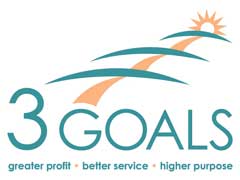
3 Goals Management System
How to Achieve Financial Abundance and Practice Freedom
A unique practice development strategy and process created by Petty, Michel & Associates
An Introduction
Goal Driven
We all have goals. When we were younger, they might have been brighter than they are now, they might have been clearer, or seemed closer. Maybe yours still are. Or, maybe, they have become dulled with wear and tear, with disappointments and frustrations.
But we are goal driven creatures and our goals stay with us. The better we can define these goals in concrete terms, the more likely we are to achieve them.
What All Doctors Want — The 3 Goals
Ultimately, all doctors would like to create a practice that allows them to provide the highest quality care to the most people for the most profit.

Most doctors want to do this with professional and personal integrity. Maybe most importantly, they want to be able to do this in such a way that they are not chained to their practice, slaving at their work at the expense of their personal and family lives.
This is a fundamental goal for all doctors, so fundamental that we call it Goal 2.
Even more fundamental, however, is basic survival and solvency. We call this Goal 1.
But nobody works just for money. Whether it’s saving the planet, helping your grand kids, assisting the poor, or funding your church, we all have higher goals.
Goal 3 are your higher purposes.
All three goals can and should be achieved, and with over 20 years of experience, we have put together a practice development system that allows doctors, and their teams, to achieve all three goals.
The 3 Goals Practice Development System is a step by step approach to help your practice grow naturally to its full potential and stay there.
Goal 1
Goal 1 is survival. In business, this means solvency. Are you making enough profit to pay your bills? To achieve Goal 1, solvency and survival, you have to move fast. It requires passion, energy, and an aggressively friendly approach to getting your services known and delivered. For the patient, you can think of Acute Care. For a staff position, you can think of 20 – 30% proficient.
Goal 2 and the Practice Development Process
Goal 2 is a fully functional, franchise-able, sale-able, and sustainable business that is very profitable. For a patient, it is a maximum spinal correction. For a staff position, it is 100% proficient and competent, rain or shine.
After you have achieved Goal 1, you can now start identifying those procedures that worked best. You can write these down on checklists. These checklists will become your Practice Playbook.
With more staff training, you can delegate more procedures to staff. As you continue to grow, you refine your procedures and continue to train your staff so that they become more competent.
Every 2 months, or as needed, you assess your list of successful procedures and add to them, or revise them. Every week you work on improving them, and train your team on them. Much like any athletic team, you practice and review your plays and procedures.
We call this process the Practice Development Process. It helps you to continually improve the practice and gradually take the office to Goal 2.
Getting Organized: The Baseball Diamond
To get to Goal 1, organization is not vital. Production, speed, and promotional activity is. However, getting to Goal 2 requires good organization.

Imagine a baseball team that stands around the pitcher’s mound with the pitcher. A batter hits a fly ball to the right field. The whole team goes to chase it. Once they reach it, they realize that no one is on the first or second base to throw the ball to in order to stop the runner. They are all out in right field.
Many offices operate this way. For example, in some offices the front desk does insurance, the insurance department does therapy, the therapist schedules appointments, and the doctor takes time off to buy office supplies.
Moving the office upward to its peak capacity includes all areas of the office improving: first base, third base, centerfield, etc. If you only have a few of the departments doing well, the other departments will hold down the entire growth.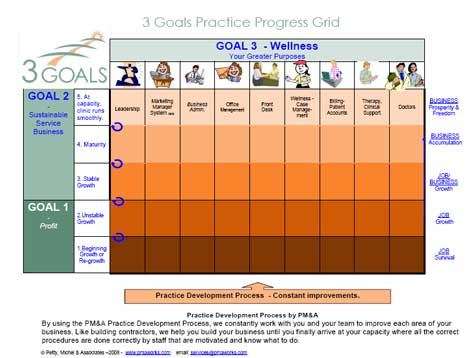
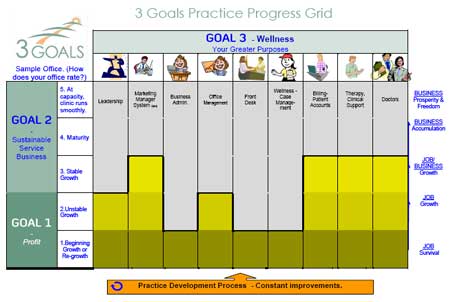
Goal Three
Our greater goals give us meaning. These are the accomplishments we want to have said we achieved at the end of our lives. They are based in love, hope, and faith. They are for our heritage, our parents and those upon whom we owe so much; they are for our legacy, our children and their children; they are for our community and the fellowship we share with rich and poor.
Goal three is your “Give Back” goals, to your family, to your community, and to yourself.
All Three
This is your road map up and out of the roller coaster. These three goals form a sequence, but you have to keep all of them in mind as you travel up your road to success.
This is directed to a business owner, but also applies to team members and how they can improve their competency. It applies to patients, and how they travel from acute care, structural care, to wellness. It actually applies to many activities.

You have to be willing to shift between goals, and if you find yourself suddenly in the poor house, you have to lose your self-important attitude and run like a rookie again until you build your business back up to Goal 1.
Where many doctors fail is that they are not willing to shift, either up, or down, as needed. Having achieved Goal 1, they are two insecure to delegate their duties to staff and procedures, or work on improving themselves. Many doctors, having achieved Goal 1 who should be working on Goal Two, feel the need to keep doing what they did to get to Goal One and so, quickly find them selves back down struggling just to survive.
It is easy to get lost, but now, with the 3 Goals Management System, you have a road map.
We have seen too few doctors achieve financial abundance and practice freedom. Hopefully, with the tools provided in the 3 Goals Management System, more doctors will be able to reach their dreams and help others do the same.
For information on our coaching and management consulting programs. LINK
(3 goals image copyright 2009)
Spring.
And almost three months into the New Year.
It was just 3 months ago when the New Year began. What about those goals you set? Those resolutions you made? How are you doing on achieving them?
You know, it is just amazing, working with the great doctors and staffs that we do. It is so evident that success is so attainable. It is just peeking around the corner, waiting for you to do just that next key action that will propel your office to pick up the speed needed to take you to the next level.
One doctor we are working with, after being in practice nearly 20 years, is hitting his best ever days and highest ever weeks this month. His staff have been emailing us their successes as if they are texting us from a rock concert!
We live for this stuff, by the way – your successes. Many times after years of gradual improvements, it is so gratifying to see an office take off with stability.
Another doctor who has been in practice for years has been breaking collections records. And volume…seems like it is nothing to have a 1000 visit month – with many if not most new patients coming in from referrals. One doctor we work with routinely sees over 1000 visits each month, and each month works with his colleagues and associates to help them hit their best-evers. Another doctor had over 150 on the books for him to see yesterday (Wednesday).
From our perspective, it looks like chiropractic is having a renaissance.
Of course, this is not the case with all of our clients. Some are still laying foundations for future growth. Success can come, but sometimes only after years of implementing the right procedures.
But what are these “right procedures”, and where do you look? Insurance department, clinic management and organization, marketing?
Some of you may feel that you are in a rut, that you and your practice are stuck. If so, take heart and have hope. Things can change and you can do better. We have seen it happen with many doctors in these last three months.
There are so many distractions in our lives, and many of them are negative and disheartening. Demoralizing. Frightening. Discouraging. Yet, we see doctors who have been stuck, finally get things going and do better. After years of stagnation, we see them do their best ever.
Practice development success is dependent on the quality of your systems and organization. That’s 50%
What’s the other 50%?
Part II

The other 50% is an “Inside Job.” That is, your success is dependent upon the structure of your office, but also on the function of your behavior. The quality, and quantity, of your energy, your attitude, and your creativity is easily 50% the cause of your success, or not.
So, if your numbers are down, you should spend half your time improving your systems, and half your time…improving yourself.
Are you frightened stiff? Have you developed “hardening of the attitudes”? Are you resentful, a seething caldron of anger? Do you feel burned out, frustrated, or feel like you just can not make the changes needed? Believe me, this manifests one way or another in your practice. And in all areas of your life.
We all experience these feelings, among others, at times. Sometimes they are acute. But after you have been in business for a while, you may not even notice that you have become less than enthusiastic about practice.
Yet, even if you were locked up in solitary confinement, you would still have the power of choice. You could still be creative. Even if you were shackled, starved, beaten, imprisoned, you could still find meaning and purpose in your life.
This is the basis of an entire branch of psychology as developed by a former prisoner of the Nazi death camps, Victor Frankl. His observations lead him to identify what he saw as the basic principles of living, including:
Successful people have meaning in their lives.
If you can find purpose and meaning in this very moment, in this day, with your next patient, with this year, your probability of success will be greatly increased. More importantly, you will find that what you are doing is more satisfying.
Fear will vanish, hardened attitudes will become flexible, and your energy will return.
Structural changes will need to take place, of course. Better clinic systems and organizational procedures will then take you to the top. And keep you there.
We can help with all of these, by the way. But you should know and be reassured that chiropractic is happening. It is hip, it is popular, and it is growing, probably more so now than ever before.
Naysayers say otherwise to promote their goods or services. They are sell outs. Don’t buy what they are peddling. Chiropractors have always been challenged and it is actually what has helped you be strong and survive. Insurance cutbacks are not new.
After more than 20 years in business, we are still amazed each day when we hear of the stories patients tell of their success.
Chiropractic works. It has, does, and will for at least the rest of this year. So, find your meanings and purposes, get help to upgrade your clinic procedures and organization, and make those yearly goals you set for 2008.
Heck — why not beat them and make this year your best ever?
Spring has its own meaning, its own purpose: to grow and create. This can be your purpose too.
Every moment, every day. Right now.
The moon is back to normal again.
Just a few hours ago, though, standing in the middle of a snow-covered playground near Lake Michigan, in the night sky at about 3 degrees above zero, it looked like a smudge. A grey brown spot that was almost black, like someone had tried to erase it with an old eraser, but part of its image still remained.
 |
For a few hours, the earth blocked out the sunlight to the moon, at least from our perspective. These unimaginably huge spheres of matter, nearly perfectly in balance, were gracefully moving like billiard balls in a ballet. Compared to this, all else really seems insignificant.
Before street lamps, car lights, TVs and late night computers, the night sky entertained us. Everyone could recognize the constellations, and an interplanetary event such as an eclipse was a very big deal. All our ancestors were stargazers – the night sky gave them the comfort of familiar signs, as well as wonder and awe. And mystery.
Besides the city lights to distract us, we have our daily duties and deadlines that rivet our attention to the near. Your patients, your notes, your computer, staff members, phones; most things are just a yard stick away. Like a ping-pong game, your focus has to be complete, quick, and close, or, you lose.
When your attention drifts, patients think you don’t care, staff thinks you take them for granted or are displeased, and insurance companies can’t read your notes. Success in practice requires keen attentiveness.
You can’t survive asleep at the wheel, dreaming or daydreaming. To be a winner you have to be alert and actively attentive to your job each minute you are at the office.
And if that is all you do, you soon will burn out.
Studies have shown that you have to, now and then, disengage. Take a break. Learn Japanese. Play with your kids. Help the poor. Pray. In their best selling book, The Power of Full Engagement, the authors offer studies and examples on why it is important to become involved in disrelated activities to balance our hectic if productive lives.
All this goes back to the moon and the sky. I don’t think we look up enough. The sky, the stars, and the whole natural God given world are about us, mysterious and awe inspiring.
In business, we have to focus on the short term and build for the middle term. But it is the far away that calls us, if we can stop to listen. What makes you curious, fills you with awe, love, and seems a mystery? What does your future whisper back to you, as if you could hear your eulogy years from now? What are your greater purposes?
Balancing these three is the key to a successful practice, business, and life. Your first goal is to play each day fast, full out, like a basket ball game you have to win. Your second goal is to gradually build a strong organization with the right teammates and the best plays that have proven to work for you. But your third goal, and there may be many, are why you work at all.
If your business has plateaued and stopped growing, it is because one or more of these goals is not being worked on correctly.
We have developed a general pathway and framework for doctors to move upward so that they can correctly work on and achieve all three goals. It doesn’t matter what technique you use, therapies, providers, or offices.
We are excited and pleased about the development of this new approach to practice management and marketing and how it impacts our consulting and the results our clients can see, as well as our own business and personal lives.
We will be publishing and just talking more about these three goals, but we encourage you to come to our seminars. You can learn more about them by clicking here. 3-Goals Seminars
And, in the meantime, as my old pal, Jack Horkhiemer the stargazer always says: “Keep Looking Up.”
photos from Microsoft and NASA
“Gratitude is not only the greatest of virtues, but the parent of all others.”
Cicero (106-43 B.C.)
Those Greeks were pretty smart, and Cicero’s statement is just one example.
According to an article in Psychology Today, gratitude is a sentiment we’d all do well to cultivate. “Feeling thankful and expressing that thanks makes you happier and heartier–not hokier.”
But more than that, when gratitude is expressed to others, many benefits occur. A simple “thank you” goes a long way in improving the morale and ultimate performance of others. Of course, it has to be genuine. Counterfeit praise is easily seen through and can do more harm than good.
According to Tom Rath, co-author of How Full Is Your Bucket, “Gallup polling has revealed that 99 out of 100 people say they want a more positive environment at work, and 9 out of 10 say they’re more productive when they’re around positive people.”
He points to research that shows when a work team has more than three positive interactions with managers for every one negative interaction, it is significantly more likely to be productive. The point is not to keep managers from correcting or reprimanding, but just to express more praise.
To improve your gratitude attitude, consider the following actions:
1. In your personal life, you can list the kindnesses of someone you’ve never fully thanked. According to Lauren Aaronson in Psychology Today, if you read this letter aloud to the person you’re thanking, you’ll see measurable improvements in your mood. She refers to studies show that for a month after a “gratitude visit” (in which a person makes an appointment to read the letter to the recipient), happiness levels tend to go up. In fact, according to her references, the gratitude visit is more effective than any other exercise in positive psychology.
2. In your practice life, list the positive contributions of each team member. Once each day, take just a moment to recognize your team member’s action and express it to them. Your communication does not have to be lavish, just a short 3 second notice of something good followed by a “thanks for the report, Dr. Smith” is all it takes.
 |
One chiropractor I worked with years ago seemed to always be in a bad mood. He was quiet and basically ignored his staff. His opinion was that he paid them to work, they should work hard, and that was it. But, his office wasn’t doing well so he called me in. I made several visits to his office, each time simply improving the communications between he and his team. I coached him on listening to each staff member and to simply acknowledge them for their contributions.
A few month’s later, we saw his practice grow. I remember this because he was always complaining to me that I was not doing anything for his office! (Sheesh!) His constant complaining and lack of appreciation was the real problem yet he just didn’t see it.
This concept is not new, of course, but it is worth remembering now and then. More studies that validate the practical aspects of this as a management tool are covered in the above referenced book. But beyond management, like Cicero says, it is just an all round good virtue to cultivate.
For a motivational tent poster with the above quote, click here.
And … thank you for taking the time to read this!
Note: If you feel you need some instant appreciation yourself, try this. (Will need speakers or earphones.)